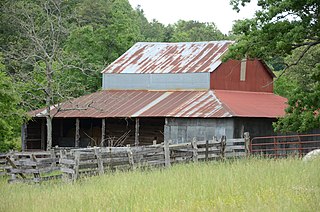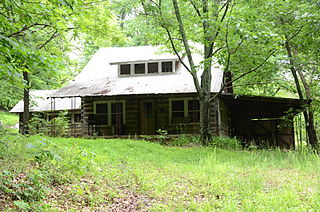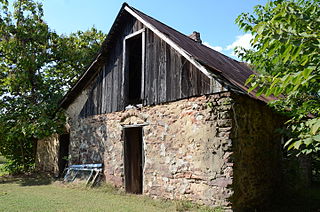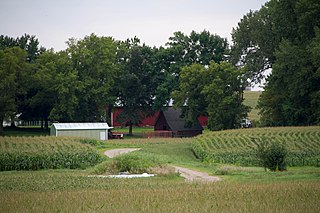Ransom House may refer to:

The Rector Log Barn is a historic barn in rural Izard County, Arkansas. It is located on the Rector Plantation, at the end of County Road 218, northwest of Melbourne. Its central portion, a log structure 2+1⁄2 stories in height, was built c. 1855, and is the only known example in the region of an antebellum era log barn. The main structure is flanked on all sides by 20th-century single-story shed-roof extensions, which serve in part to protect the historic log elements. The barn was built by Joseph William Rector, an early settler of Izard County, probably with the use of slave labor.

The Sylvester Smith Farmstead is a historic farmstead in rural Izard County, Arkansas. It is located on the south side of County Road 10, about 0.75 miles (1.21 km) northeast of its junction with County Road 13 in Boswell. The central feature of the farmstead is a single story Plain-Traditional wood-frame house, built in 1922 by Sylvester Smith, a prominent local farmer who also served as the local railroad telegrapher and agent. Smith built a barn, chicken house, smokehouse, and corn crib the following year, and the complex grew in later years to include a garage and privy. It is one of the best-preserved and least-altered farmsteads of the period in the county.

The Rife Farmstead is a historic farm property in rural Benton County, Arkansas. Located on the west side of County Road 47 about 1.25 miles (2.01 km) north of its junction with Arkansas Highway 264, it consists of a single-story Bungalow-style stone house with a front-gable roof, and a side gable projecting portico. The house was built in 1928 by Luther Rife, and is unusual in this rural setting, where most houses are vernacular in form. The property original had two c. 1910 barns when the property was surveyed in 1988; these are apparently no longer standing.
The Blunt House Livestock Barn is a historic barn in rural White County, Arkansas. It is located on the north side of County Road 94, west of the hamlet of Midway. It is a wood-frame structure 1+1⁄2 stories in height, with a gambrel roof and a shed-roof ha storage extension to the east. It is finished in board-and-batten siding; its roof is corrugated metal. Built c. 1920, it is the county's best example of barns built between about 1914 and 1939. The barn is somewhat rare, as gambrel roofs were not commonly used in barn construction in the county before 1930.
The Joe Brown House and Farmstead is a historic property in rural White County, Arkansas. It is located about one mile south of the end of County Road 529, and about 2 miles (3.2 km) north of the hamlet of Little Red as the crow flies. It is a single-story dogtrot house, with a corrugated metal roof and board-and-batten siding. The front facade has a shed-roof porch extending across part of the front, sheltering two entrances giving access to the two pens and the breezeway. The property includes a well and the remains of a log smokehouse. The house was built about 1890, and is one of White County's few surviving 19th-century dogtrots.

The Orvall Gammill Barn is a historic barn on the northeast side of Stone County Road 87 northwest of Big Springs, Arkansas. It is a two-story structure, built out of a combination of logs and timber framing, with a gable roof, the gable oriented toward the road. It is built in a transverse crib pattern, with a series of log cribs fashioned out of hand-hewn logs joined by V notches, with a wood framed loft area above. A shed addition extends along the building's north side. It was built in 1922 by Orvall Gammill, and is locally unusual due to its transverse crib form being executed in logs rather than lumber framing.

The Childers Farmstead is a historic farm property in rural southern White County, Arkansas. It is located south of McRae, near the junction of Bowman and Rip Kirk Roads. The farmstead includes three buildings: the main house, a large barn, and a small "Delco house", originally built to house electricity generation equipment provided by Delco Electronics. The main house is a vernacular single story wood-frame structure, with a hip roof and a shed-roof porch extending across its main (northern) facade. That facade is symmetrically arranged, with Craftsman-style windows on either side of the entrance, which is flanked by half-length sidelights. The house was built about 1925, and is an unusual example of a retro version of Greek Revival architecture with Craftsman features. It was torn down in 2020.

The Pinky Pruitt Barn is a historic barn on the south side of Arkansas Highway 14, just west of St. James, Arkansas. It is a single-crib structure 1+1⁄2 stories in height, built out of rough-hewn logs, with a stone pier foundation. It is surrounded on three sides by open sheds supported by log posts. It was built about 1890, and is reflective of the earliest form of barn built in Stone County by arriving settlers.
The Morris Hartsell Farmstead is a historic farm property in northern White County, Arkansas. Located on the north side of Arkansas Highway 157 in the hamlet of Steprock, it has one of the finest assemblages of 19th century farm buildings to be found in the county. Its main house is a single-story double-pen structure with a gable roof and a massive stone chimney at one end. One pen is built out of hand-hewn logs, while the other is framed in dimensional lumber. The second pen dates to about 1880, and the building has been little changed since then. Also included on the property are an equipment shed, and a large timber-framed barn, both of which appear to date to the same time.
The May Farmstead is a historic farm property in rural eastern Newton County, Arkansas. It is located overlooking Cave Creek, off County Road 256 east of Bens Branch Church. The main house is a double-pen, one built out of logs in 1880, the other framed in 1910. The house is sheathed in weatherboard siding added after the construction of the second pen, and there is a full-width porch extending across the front (southeastern) facade. The property also includes a period barn and spring house. It is one of the best surviving examples of a late 19th-century farmstead in the region.

The Williams House and Associated Farmstead is a historic farm property in southern Madison County, Arkansas. It is located northeast of St. Paul, at the end of County Road 172. The main house is a 1+1⁄2-story log structure, fashioned out of hand-hewn timbers fitted together with dovetail joints and concrete chinking. The property includes a barn, smokehouse, chicken house, and privy, all of which were built around 1922–25. The house was built in 1935, and is locally unusual for the late date for the use of log construction to build a pioneer-style house.
The Brady Hays Homestead was a historic farmstead in rural northern White County, Arkansas. The property included a house and barn built about 1885 by Brady Hays. The house was a double pen frame house of vernacular style, and the barn was a notably large two story transverse crib design, incorporating an older barn into its structure.

The Louis N. Hilger Homestead/Livestock Barn is a historic barn in rural northern White County, Arkansas. It is located on the south side of County Road 374, west of Providence. It is a two-story wood-frame structure, with a gambrel roof, hay hood, board-and-batten siding, and a concrete foundation. It has a transverse crib layout, with a livestock shed extending along one side. It has two shed-roof dormers on the east side, providing light to the interior. It was built in 1939 to house mules used as draught animals for the Hilger dairy operation, and is distinctive within the county for its use of dormers and its extraordinary height, made possible by its braced-frame construction.

The Hoofman Farmstead Barn is a historic barn in rural White County, Arkansas. It is located north of Searcy, on the west side of Salem Church Road. It is a stone structure, 1+1⁄2 stories in height, with a wood-frame gabled roof. It is basically rectangular, with a stone shed-roof extension on one side, giving it a saltbox profile. Built about 1920, it is the largest and possibly oldest historic stone structure in the county. It was built to serve as a large root cellar.

The Tobe Hoofman Farmstead is a historic farm property in rural White County, Arkansas. It is located on the west side of Arkansas Highway 13 north of Judsonia and Arkansas Highway 157. The property includes a farmhouse, wellhouse, barn, and storm cellar on about 40 acres (16 ha) of land. The farmhouse is a vernacular 1+1⁄2-story wood-frame building, with a gable roof and a hip-roof porch with small gables over its access stairs. The wellhouse is a small wood-frame structure with a hip roof; the storm cellar is an earthen structure, mostly below ground, with a small above-ground access building. The barn is a transervse crib wood-frame structure with a gable roof. The farmstead was developed about 1910, and is a little-altered example of an early 20th-century farmstead.

The Livestock and Equipment Barn of the Glenn Homestead is a historic farm outbuilding in rural northern White County, Arkansas. It is located on the north side of Arkansas Highway 124, several miles east of the city of Pangburn. It is a two-story frame structure, clad in novelty siding and set on a concrete foundation. Its main section has a visually distinctive rounded roof, with open shed-roofed equipment wings on the sides. Built about 1939, it is the only known round-roofed barn in the county.

The Walker Homestead Historic District encompasses a collection of related agricultural and homesteading properties in rural White County, Arkansas. Located on Gum Spring Road about 1 mile (1.6 km) east of Arkansas Highway 267 southwest of Searcy, the district includes two farmstead houses, a barn, tenant housing, cotton gin, and other features. The oldest portion of the oldest house is a single pen log structure built about 1850 by William Walker, one of the area's early settlers, while the other house is a c. 1900 vernacular Greek Revival structure built by Billy Walker, Sr. The district encapsulates a typical evolutionary history of rural properties in the region, and was listed on the National Register of Historic Places in 1992.

The Jim Wright Farmstead Historic District encompasses a well-preserved early 20th-century farmstead in rural White County, Arkansas. The property is located on the south side of Arkansas Highway 258, east of its junction with Arkansas Highway 323, northwest of Bald Knob. It includes a Craftsman style single-story wood-frame farmhouse, with a wraparound porch supported by simple Doric columns, a simple wood-frame garage, and a single-story wood-frame house for tenant workers. It also includes remnants of the farmstead's first house and barn, silo, and a cattle dipping vat. This land was homesteaded in 1860 by the parents of Jim Wright, who is credited with construction of most of the farmstead's surviving features, which were built between 1924 and 1940.

The Johann Schimmelpfennig Farmstead is a farm in Benton Township, Carver County, Minnesota listed on the National Register of Historic Places. The log and wood-framed buildings, built between 1856 and 1909, demonstrate the evolution of Minnesota farmsteads during that era.















